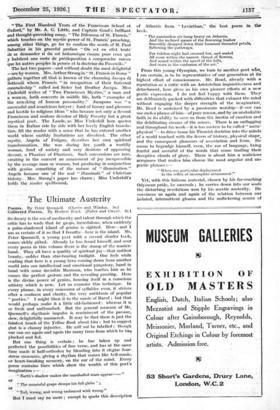A Symposium of St. Francis
THESE essays will interest all Franciscan students and delight those simple lovers of the Saint who cannot aspire to the name of student at all. To the latter class such articles as " The Study of the Sources of the Life of St. Francis," by Professor F. C. Burkitt, and " The Little Flowers of St. Francis," by Professor Edmund Gardner, may prove rather hard- reading.' The -concltisioin.*arrived aftet much neces- sarily involved argument, that later sources not uncommonly represent earlier tradition, somehow comes as an anticlimax ! and makes the reader feel there has been much ado about nothing: --He -will be thankful, however, to find the-" Mirror of Perfection " and the " Little Flowers " still pretty firm in his hand though disfigured by many notes and queries. " The Rediscovery of St. Francis " and " The Last Two Years of the Life of St. Francis of Assisi," by Mr. Seton, should hold the close attention of both learned and unlearned, the latter at any rate will be delighted to see that a scholar of such eminence records his belief in the evidence supporting the record of the stigmata.
Signor Camillo Pellizzi's " Franciscan Thought and Modem Philosophy " should again make a double appeal. It has all the clarity of great knowledge and yet must inspire in any intelligent man of ignorance a desire to know something more of scholastic philosophy. " The First Hundred Years of the Fronciscan School at Oxford," by Mr. A. G. Little, and Captain Goads brihieut and thought-provoking essay, " The Dilemma of St. Francis," which touches on the mystic power of St. Francis' preaching, among other things, go far to confirm the words of M. Paul Sabattier in his graceful preface " On est en effet tents de se demander si du sol britannique enuine pour ceux qui y habitent une sorte de predisposition it comprendre mieux que les autres peuples la pence et lit doctrine du Poverello."
The last two papers—and without doubt the most delightful --are by women. , Mrs. Arthur Strong in " St. Francis in Rome " gathers together all that is known of the, charming Jacopa di Settesoli whom Francis " in recognition of their fraternal comradeship " . called not Sister but Brother Jacopa. Miss Underhill writes of ." Two Franciscan Mystics,", a man and a woman, both _converts in middle life, both " examples of the remaking of . human personality." Jacapone was " a successful and avaricious lawyer ; fond of luxury and pleasure and hostile to religious ideas " who became not only a devout Franciscan and zealous devotee of Holy Poverty but a great mystical poet. The Laude, as Miss Underhill here quotes them in Italian side by side with her lovely English transla- tion, fill the reader with a sense that he has entered another world where earthly limitations arc dissolVed. The other mystic, Angela of Foligno, describes her own spiritual transformation. She was during her youth a worldly woman, fond of society and very desirous of appearing devout, a Pharisee of PharisceS. Such conversions are rare, creating in the convert an amazement of joy inexpressible by the average man or woman, but producing in conjunction with genius something of the nature of " illumination." Angela became one of the real " illuminati " of Christian history. Mrs. Strong's paper has charm ; Miss Underhill's holds the reader spellbound.



































 Previous page
Previous page